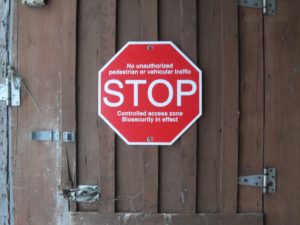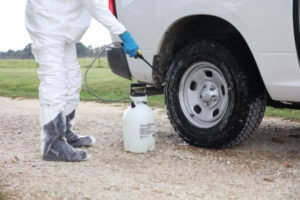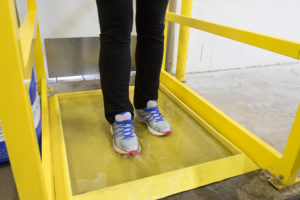February 17, 2022
Biosecurity is the first line of defense to protect hens from HPAI. Now is the time to increase biosecurity to the highest level possible to lower the risk of introducing HPAI to a farm.
Have someone who isn’t involved in the day-to-day operation of your farm review your plan, watch biosecurity practices in action, and provide suggestions for improvements from their fresh perspective. Adapt the plan to address increased risk.
Ensure all farm workers are trained. Work with onsite personnel and verify the plan is being followed by all employees all the time.
Monitor farm entrance and allow essential personnel only. Require all visitors sign in and confirm they have not been on other farms in the past 48 hours.
Inform contract crews, service personnel, consultants, and other visitors about your biosecurity procedures before they arrive onsite.
Know the recent travel/movement history of potentially contaminated equipment and vehicles (rendering or manure trucks).
Place locked barrier at the site entrance to keep nonessential people, vehicles and items from entering the buffer area.
Limit all unnecessary traffic - arrange offsite delivery drop-off locations if needed.
Reduce cross-traffic of personnel and vehicles by having separate pick-up locations for mortality and manure in areas used to house birds.
Post signs (in multiple languages if appropriate) to remind employees of biosecurity protocols before entering and when leaving barns.
Provide site-specific coveralls, footwear and cleaning and disinfectant supplies. Designate areas for all persons entering barns to clean and disinfect and change clothing and footwear.
Have hand sanitizer or hand washing stations at the entry into the barn.
Clean and disinfect anything entering barns. Do not move items, equipment, supplies between barns - purchase and designate materials specific to each barn if necessary.
Clean and disinfect all vehicles before entering the buffer area. Pay special attention to tires, wheel wells and undercarriage areas.
Park vehicles outside of the buffer in a designated area.
Do not share equipment with other farms.
Ensure feed delivery trucks are covered to prevent contamination.
Scan the environment around the buffer area and barns for wild waterfowl droppings frequently and remove them promptly. Eliminate standing water.
Frequently check barn roofs, eaves and ventilation for openings.
Remove any spilled feed immediately and make sure the feed supply is secure.
Ensure wild birds cannot access your water supply. Use water from a contained supply if possible.
Place filament lines over ponds to deter wild birds.
Develop farm-specific training and provide maps showing the perimeter buffer and the line of separation. Train employees frequently on biosecurity so they understand how to:
Offer training in multiple languages as needed for the workforce. Use the buddy system to encourage teams to follow biosecurity measures properly every time.
Instruct employees to change protective gear before going into another barn.
Instruct barn workers to notify a supervisor immediately if they see sick birds, reduced water consumption or unusual mortality.
Restrict employees from working on other farms or having birds at home. Train employees who hunt wild birds and are at greater risk of introducing HPAI on your farm.
For video, photos and other resources, view Resources.
For media inquiries or
interview requests, contact Hinda Mitchell.